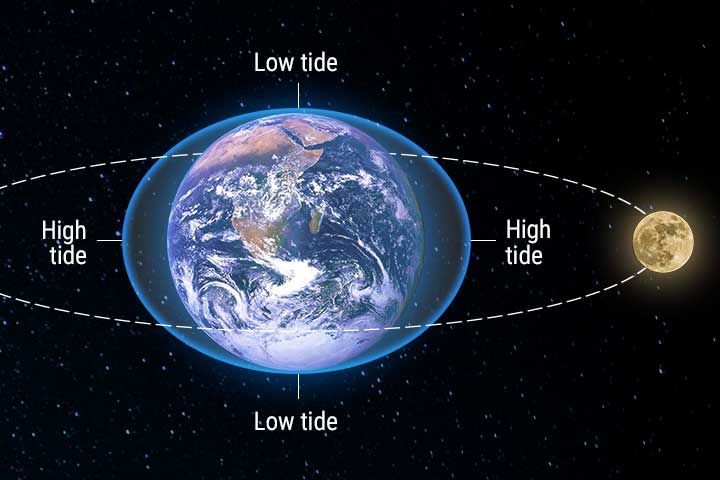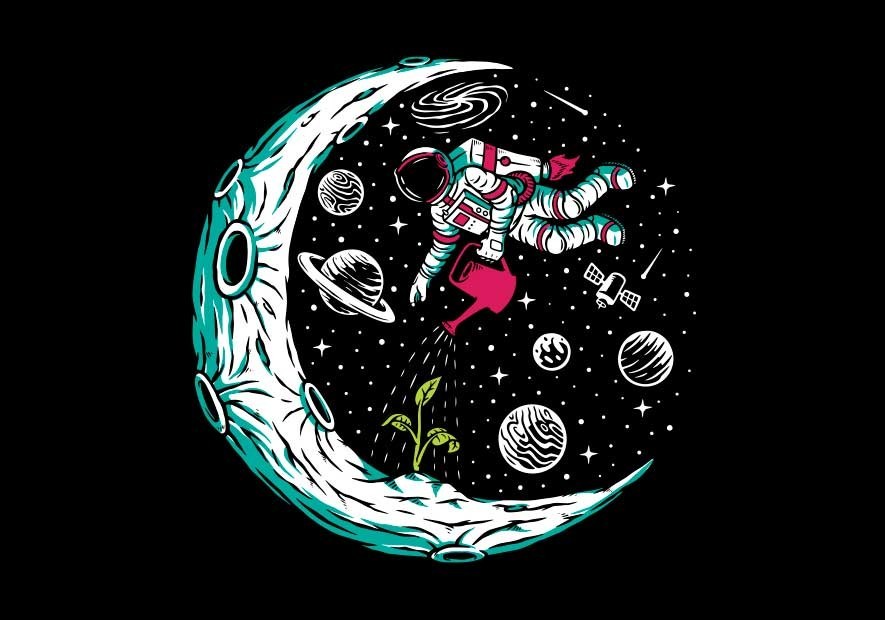Moon Calendar: How to use

The gravity of the Moon and the Lunar calendar can become your friends in successful growing of plants. Phases and cycles of the Moon, tidal effects, useful tips.
Contents
- Moon Phases
- Moon Cycles
- Tidal Effects
- Daily Rhythms
- Elements and Zodiac signs
- Useful tips: How to use Moon Growing Calendar
Download Moon Growing Calendar 2024
It will help you determine the best days for planting, germination, transplanting, fertilizing, pruning, training, harvesting, and pest control. Calendar is in English.
- Moon_Growing_Calendar_2024_А4.pdf — for printing, 7 pages А4
- Moon_Growing_Calendar_2024_А4.pdf — for printing, 2 pages А3
Moon Phases

🌑 New Moon
At this stage, the Moon remains invisible to observers on Earth, since its dark side faces us. During this phase, it is not recommended to process plants, however, pruning dry or diseased branches is acceptable.
🌓 Waxing Moon
The period between the new moon and the full moon when the right side of the Moon becomes visible and gradually emerges from the shadow. The internal activity of plants increases, their resistance to pests and diseases increases. Pruning is not recommended at this time.
🌕 Full Moon
This is the time when the Moon is fully illuminated. Plant juices are directed upward to the above-ground parts. Pruning is not recommended, but this is the ideal time to germinate seeds.
🌗 Waning Moon
This is the period between the full moon and the new moon when the right side of the moon gradually sinks into shadow. Plant juices sink into the underground parts, the soil becomes more pliable. Ideal time for watering and fertilizing. It is also recommended to harvest, since beneficial substances and aromas are better preserved during this period. It is not recommended to carry out sowing, planting and replanting.
Moon Cycles (not to be confused with Phases!)
When continuously observing the Moon, we can notice that its trajectory changes slightly every day. Over the course of 13–14 days, the Moon rises higher (Moon Ascending), reaches a peak, and then falls over the next 13–14 days (Moon Descending). Both of these periods add up to 27.3 Earth days, during which the Moon makes a full revolution around the Earth.
During the year, the Earth passes around the Sun, making its way along the ecliptic. The Moon's orbit is inclined at an angle of 5° to the ecliptic, which causes the Moon to either rise above the ecliptic (ascending cycle) or sink below it (descending cycle). Thus, every day we can observe a change in the trajectory of the Moon.

Ascending Moon
At this time, the liquids in the plants rise, nutrients are directed to the upper parts of the plant. This is the ideal time to cut and prepare clones. However, it is recommended to avoid harvesting if you plan to do subsequent drying.
Descending Moon
The best time to plant and germinate seeds. During this period, the liquids in the plants sink down, increasing the activity of the underground parts. The descending Moon essentially “pulls” the lower parts of the plant into the soil. Here it is advisable to work on the roots, sow and germinate seeds, and also enrich the soil.
What affects more — the phase of the Moon or its cycle?
The answer to this question depends on geographic latitude. In Europe, the moon's cycle (ascending or descending) has the greatest influence. Meanwhile, the closer to the equator, the greater the effect of the moon phase (waxing or waning).
Tidal Effects
Every day there are two high tides and two low tides on the surface of the Earth. It should be noted that the impact of the morning tide is felt more intensely compared to the afternoon tide, and the impact of the afternoon tide is greater than the morning one.
The interval between high tide and low tide is approximately 6 hours, during which the water gradually recedes. The same amount of time is required for the reverse process — from low tide to high tide.

The gravitational influence of the Sun also has a noticeable effect on tidal waves, but it is approximately two times weaker than the gravity of the Moon. During the new and full moon periods, tides are higher because the tidal forces of the Sun and Moon are directed in the same direction. During the first and third quarters of the Moon, the height of the tides decreases as the tidal forces of the Sun and Moon oppose each other.
During high tide on the 🌗 waning Moon, it is recommended to vaccinate cuttings, cultivate the soil, prepare compost or harvest.
During low tide, it is recommended to do sowing (if the Moon is é ascending), replanting, cultivating loose soil and applying fertilizers.
Important! In the calendar, the tide schedule is calculated for the eastern part of the Baltic Sea and the UTC +2 time zone.
Daily Rhythms
The energy of planet Earth is closely related to its seasons. In the spring, when the Sun rises higher, the Earth, in fact, “exhales” — its vital energy rises and is directed outward. While in the fall, when the Sun slowly descends, the Earth “inhales” new energy, taking it into itself. The Moon also follows a similar cycle — the ascending Moon is called “Lunar Spring”, while the descending Moon is called “Lunar Autumn”.
The first half of the day is when it is recommended to sow or harvest.
The second half of the day (afternoon) — energy is directed into the Earth, therefore it is best suited for planting, transplanting or enriching the soil substrate.
For several hours in the afternoon (from approximately 12 to 15 hours), it is recommended to refrain from performing important work.
Elements and Zodiac signs
Some consider the position of the Moon in the Zodiac to be an important factor when working with plants. The lunar month is divided into 12 sectors along the ecliptic, each of which lasts approximately two days, and each sector is named after the corresponding constellation.
The position of the Moon in each of these 12 constellations has its own effect on plants. In addition, these constellations are united into “influence groups” according to the elements - Fire, Air, Water and Earth. Each element stimulates certain biodynamic processes in plants, thus affecting different parts of the plant.
Elements
Element of Fire (Seeds and Fruits) — ♈ Aries, ♌ Leo and ♐ Sagittarius. The time when the Moon passes through these signs is considered the best for sowing seeds and developing the fruiting parts of plants.
Air Element (Flowers) — ♊ Gemini, ♎ Libra and ♒ Aquarius. This period is ideal for the development of flowers and various work on planting and caring for plants.
Element of Water (Leaves) — ♋ Cancer, ♏ Scorpio and ♓ Pisces. At this time, leaves, stems and branches are in active growth, which makes it suitable for planting and caring for the above-ground parts of plants.
Earth element (Roots) — ♉ Taurus, ♍ Virgo and ♑ Capricorn. This is the best time for all types of root work, including strengthening the root system and getting rid of unhealthy roots.
Zodiac Signs
| ♈ | Aries | Fruits | é | Ascending Moon |
| ♉ | Taurus | Roots | é | Ascending Moon |
| ♊ | Gemini | Flowers | ê | Descending Moon |
| ♋ | Cancer | Leaves | ê | Descending Moon |
| ♌ | Leo | Fruits | ê | Descending Moon |
| ♍ | Virgo | Roots | ê | Descending Moon |
| ♎ | Libra | Flowers | ê | Descending Moon |
| ♏ | Scorpio | Leaves | ê | Descending Moon |
| ♐ | Sagittarius | Fruits | é | Ascending Moon |
| ♑ | Capricorn | Roots | é | Ascending Moon |
| ♒ | Aquarius | Flowers | é | Ascending Moon |
| ♓ | Pisces | Leaves | é | Ascending Moon |
Useful tips: how to use Moon Growing Calendar
Substrate preparation
Especially relevant for outdoors. It is important to prepare the substrate during the descending Moon, in the waning phase (between the 4th day after the full moon and the new moon), in the earthly sign of the Zodiac (Taurus, Virgo or Capricorn).
Germination
For optimal development of crops, germination is recommended to be carried out on the descending Moon, approximately 3 days before the full moon. It is also recommended to combine the phases of the moon with the earth sign.
Transplantation
Transplantation is stressful for plants, so it is important to choose a favorable moment. It is recommended to choose a moment when the Moon is descending, but in the waxing phase (between the new moon and the full moon), in an air sign (Gemini, Libra or Aquarius).
Root and foliar fertilizing
Spraying fertilizers on the leaves is best done with the rising Moon in the waxing phase in water signs (Cancer, Scorpio, Pisces). When root feeding — with the descending Moon also in the waxing phase, in earth or air signs. It is more effective to apply fertilizer in the morning than in the afternoon, and avoid fire signs (Aries, Leo, Sagittarius).
Pruning
For pruning plants, it is recommended to choose a descending Moon in its waning phase and an air sign. When pruning roots, it is better to choose an earth sign.
Clone cutting
The best time to cut clones is when the Moon is rising in air signs, in its waxing or waning phase.
Planting clones
Seedlings should be planted in fire signs on the descending Moon in the waxing phase.
Branch staking or LST (Low Stress Training)
To minimize stress when tying up plant branches, it is recommended to choose the rising Moon in the waxing phase: at veg — in water signs, and at flowering — in air signs.
Insecticides and fungicides
Spraying insecticides on the leaves should be done by the rising Moon in water signs, preferably in the waxing phase. Insecticides are best applied in the morning, and fungicides in the afternoon. Preparations for root application are more effective when used on the descending Moon in the waning phase in earth signs.
Harvesting
The ideal moment for harvesting is the descending Moon in its waning phase in air signs. It is preferable to collect in the morning and during low tide to remove as much moisture as possible from the inflorescences.
In Conclusion
The decision to trust the Lunar calendar is a personal choice. It is important to remember that the Lunar calendar provides only recommendations, and decisions should be based on common sense and practical experience. Lunar calendar advice does not guarantee an ideal result, because it is just one of the tools for successful cultivation. May your harvest be rich and inspiring!


Leave a comment